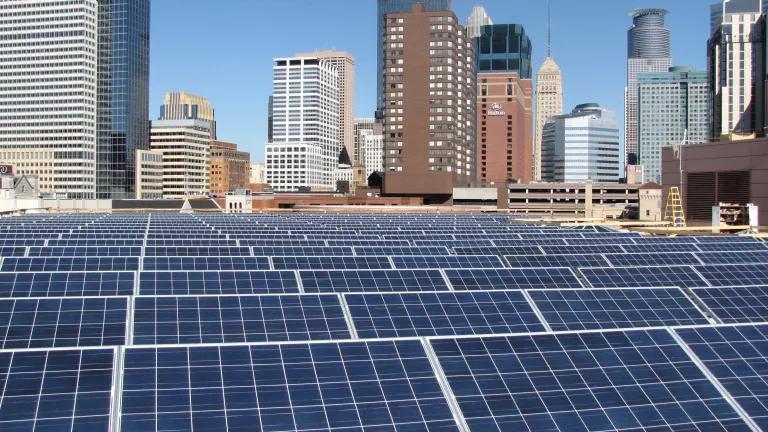Saving Water and Energy through Clothes Washer Replacement
The average family washes almost 300 loads of laundry each year—which requires a significant amount of water and energy.
The average family washes almost 300 loads of laundry each year -– that's almost six loads every single week. Clothes washers use significant amounts of water for washing -– they represent up to 20 percent of a typical household's indoor water usage. They also consume energy by using hot water for some cleaning cycles, agitating clothes to remove dirt and stains, and spinning clothes to remove excess moisture.
Clothes washers have become much more efficient in the past two decades -– between 1987 and 2010, the average energy use of clothes washers has declined by 75 percent. Federal appliance efficiency standards have played a critical role in reducing the amount of water and energy that these appliances use, and by consequence, have saved consumers money. The newest efficiency standards for residential clothes washers are raising the bar even more and will save an estimated 160 billion gallons of water by 2025 –- that's enough to meet the daily needs of nearly 3 million people. While appliance efficiency standards help to increase the efficiency of all new clothes washers on the market, the ENERGY STAR program helps recognize the models that can save even more energy and water.
How much can be saved by using ENERGY STAR clothes washers?
If you are already in the market for a new clothes washer, ENERGY STAR washers on average use 20 percent less energy and 35 percent less water than basic models of new washers on the market today. Those savings can add up quickly. An ENERGY STAR washer saves approximately 284 kWh of electricity and 3,385 gallons of water a year compared with a non-ENERGY STAR model. For the average consumer, that translates into savings of $60 on your utility bills. Further, you reduce emissions by approximately 437 pounds of carbon dioxide annually and that is equivalent to the emissions saved by not driving your car for 15 days.
If you have a traditional top loading clothes washer with a large center agitator that works fine, you’ll still want to consider replacing it to take advantage of the significant improvements in clothes washer efficiency that have occurred in recent years. Even if your current top-loader is only four or five years old, a new ENERGY STAR model can reduce your energy and water use by 70 percent or more.
What is NRDC doing?
NRDC experts are working with the American Council for an Energy-Efficient Economy (ACEEE) to develop and implement an innovative incentive program that saves energy and water in the Great Lakes Region. Since clothes washers in multifamily laundry rooms and laundromats are used more frequently, there are many opportunities to achieve energy and water savings with these machines. They include:
- Incentivizing property owners to purchase ENERGY STAR clothes washers
- Upgrading to larger capacity machines that are also more efficient
- Adopting incremental pricing based on the energy used by different temperature settings
On average, an ENERGY STAR commercial clothes washer will use 15 percent less electricity, 60 percent less natural gas and 47 percent less water per year compared to a conventional washer. Laundry facilities also can save an additional 20 to 30 percent on energy used per load by charging different prices for hot, warm and cold water washes. Across the Great Lakes, these changes could annually save 22 GWh of electricity, over 1.1 million MMBtu of natural gas and 971 million gallons of water. This is comparable to the amount of electricity used annually by 2,200 households, the amount of natural gas annually used to heat more than 18,200 homes and the average amount of water used by nearly 36,000 people each year.
For more information, please see our white paper, Saving Energy and Water through State Programs for Clothes Washer Replacement in the Great Lakes Region.
NRDC is also advancing a proposal for California to suspend the state sales tax on high-efficiency clothes washers for the duration of the drought emergency. Given the significant amount of water that clothes washers consume, this proposal would complement existing utility incentive programs to accelerate the transition to high-efficiency clothes washers and help to achieve a significant portion of the 20 percent reduction in household water use that Governor Jerry Brown has called for.
Laundry Tips
- Wash your clothes in cold water whenever possible. New cleaning agents found in many high-efficiency detergents perform just as well or even better in cold water.
- Turn down the thermostat on your water heater to 120°F. Most water heaters are set at 140°F when 120°F is sufficiently hot for most household needs.
- Wait until you have a full load before washing. If washing a smaller load, adjust the water level setting appropriately.
- Don't use the "sanitary cycle" setting on your washer unless absolutely necessary. This cycle, which heats water to higher temperatures, uses significantly more energy.
- To save energy, money and extend the life of your clothes, line-dry them. But if you intend to use a dryer, use the "high spin speed" or "extended spin" washing option to remove excess moisture from your clothes. This will reduce the amount of time and energy needed to dry your clothes in the dryer.
- Consider installing a laundry-to-landscape gray water system, which uses gray water from your clothes washer instead of potable water to irrigate your yard.


